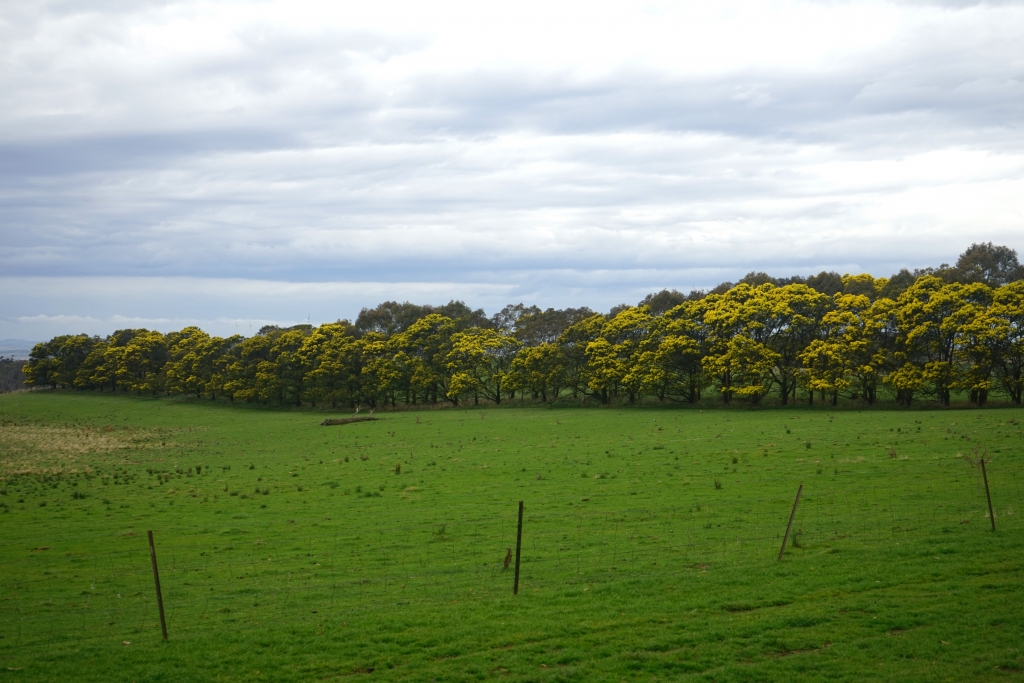
John Weatherstone pictured with Snowy River Wattle (Acacia Boormanii) on National Wattle Day.
The fields are alight with wattle blooms signalling spring’s start. In the Kanangra-Boyd to Wyangala Link (K2W), ten wattles are flowering this National Wattle Day, including the Red stemmed Wattle (Acacia rubida) the Western Silver Wattle (Acacia decora) the Green Wattle (Acacia decurrens) often mistakenly called the Early Black Wattle, and Chalkers Wattle (Acacia chalkeri) which grows in a small area around Wombeyan Caves and typically flowers between October and January.
Known commonly as acacias, almost 1000 species occur nationally making them the largest group of flowering plants in Australia.
In farming, integrating wattles as part of a sustainable habitat adds value to landholders, said John Weatherstone, an assessor for Land for Wildlife (LfW). K2W Link supports LfW assessors who assist landholders in integrating nature conservation with other activities, such as grazing. Wattles have considerable potential in revegetation programs that positively impact the environment and animals.
“Whole paddocks are planted with widely spaced rows of trees, which are grazed between when the trees are large enough,” John said.
He said this type of planting has proved to increase livestock productivity and improve stock health.
“At Binalong, where this technique was initiated, research indicated that chemicals in the leaves of some wattles, especially Black Wattle (Acacia mearnsii) resulted in a decrease in internal parasites. Stock also had increased productivity from reduced heat stress and protection from cold and windy weather,” said John.

Wattle benefits include improved stock health, more macronutrients in the soil and acts as a natural pest control.
“They are (mainly) pioneering plants, which establish quickly and act as a nurse crop for Eucalypts and other longer-term trees and shrubs.”
Another important function of wattles is restoring the nitrogen balance within ecosystems that benefit other plants. “Wattles are legumes which extract nitrogen from the atmosphere and make it available in a plant-available form for other trees and shrubs,” he said. This process is similar to how clover adds nitrogen to a pasture.
Other plant uses
They produce food for insects and encourage wildlife, including many bird species. “Wattles produce pollen which provides food for insects, which encourage the presence of birds, and as there are different species that flower at most times of the year, this provides a more regular food source for birds,” he said.
Many wattles produce an essential winter food source for possums, particularly the Sugar Glider (Petaurus breviceps) when other energy-rich food sources, such as nectar and some insects, are scarce.
Apart from attracting wildlife, they are a natural pest control, the dense foliage offers shade and shelter, and reduces erosion. The timber of larger wattles, especially Hickory wattles, is high-quality, while thinnings from direct seeding can be used for firewood. And its iconic beauty is synonymous with the nation’s history.
Its traditional uses by First Nations were as a source of nourishment with medicinal properties.
Wiradjuri man Adam Shipp has been working with native plants and in the environment around Ngunnawal country, near Canberra for decades. Now, through his company, Yurbay, in Wagga Wagga, he is sharing knowledge of traditional plant use with land owners and environmental organisations.
He said that in Wiradjuri culture, the seeds of Light Wood Wattle (Acacia inflexa) were ground to make flour.
“It also has a number of medicinal properties in the bark, which are used for pain relief and as an anti-inflammatory for rheumatoid arthritis, Adam said.
“Large strips of the bark were stripped and soaked in water and used as a bathing type to relieve sore joints. The leaves are crushed and made into soap.”
These days, Wattleseed is commonly used and commercially developed for the bush food industry, even featuring in McDonald’s McCafe menus. In 2022, McCafe introduced the Australiano, a combination of wattleseed, chai and roasted coffee beans.
Land for Wildlife
LfW is a free and voluntary property registration scheme for landowners who wish to manage areas for wildlife and native vegetation. The program’s cornerstone is a one-on-one visit by the local officer who will help landowners develop a personalised property plan.
Read more about the LfW program at Community Environment Network.
